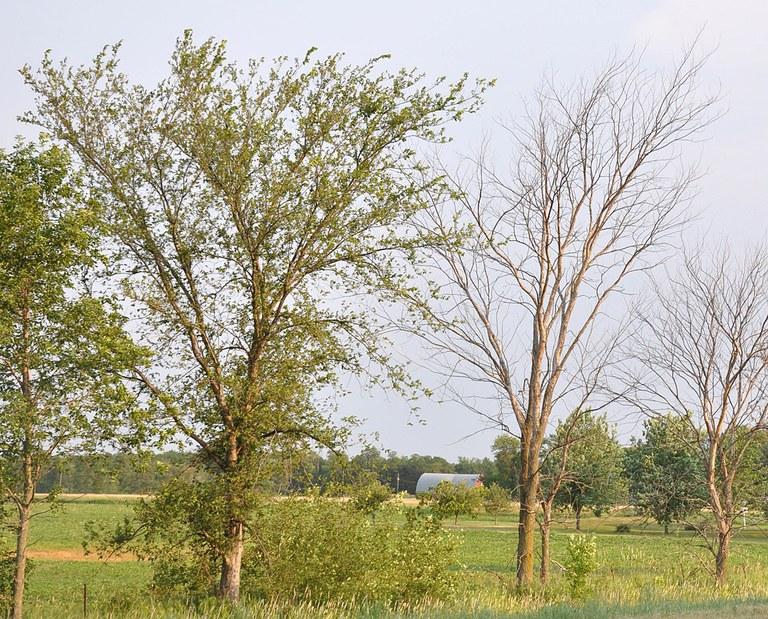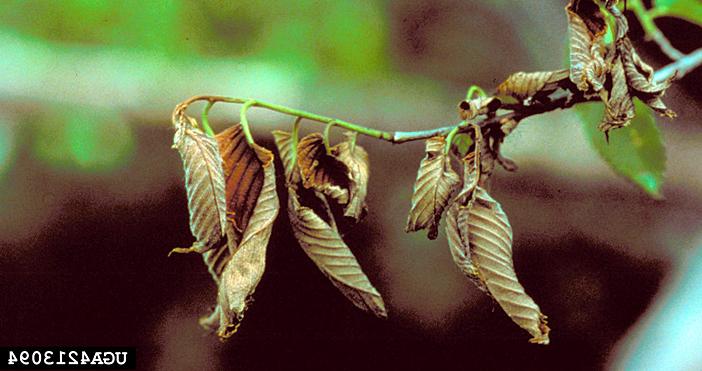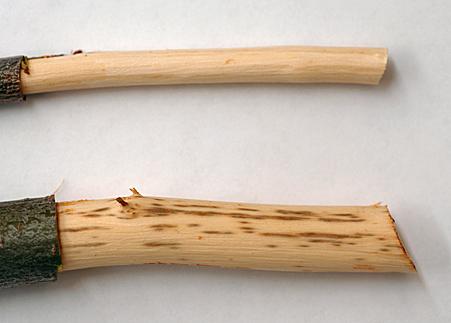有几个用于DED的管理工具可用. Using them in the appropriate situations 和 combinations is the best way to reduce DED 和 limit its spread.
环境卫生. A year-round communitywide sanitation program is an extremely effective way to slow the spread of DED. Because elm bark beetles breed in dead elm wood with intact bark 和 in dying elm trees, 清除这些甲虫栖息地是至关重要的. 这包括在风暴过后移除受损的树枝, trees weakened by pest attack 和 fresh elm firewood (all species of elm).
处理受感染榆树木材的常用方法包括焚烧, 埋葬, 把榆木削碎或剥皮. 使卫生设施有效运作, identifying newly infected trees continuously throughout the growing season each year 和 removing them promptly (within 2-3 weeks) is essential. Failure to do so may result in a surge in elm mortality in the following years. A strong municipal ordinance that clears the way for communitywide sanitation on public 和 private property also is essential to this effort.
修剪. If infections are identified early enough, they can be removed by pruning. At least 8 to 10 feet of wood that is free of vascular discoloration needs to be removed below the symptomatic branches. 修剪应在10月至次年3月进行. 这些修剪过的树枝应立即销毁.
Remember to disinfect pruning tools with a 15-20 percent household bleach solution after exposure to DED-infected trees. 由于不确定修剪掉所有受感染的木材, trees pruned in an attempt to remove DED-infected branches should be monitored closely for the development of symptoms below the pruned area.
切断根嫁接. To limit the spread of DED through root grafts, the area around infected elm trees can be trenched. 如果不到25%的树冠被DED损坏, 然后切断根移植物是一个可行的治疗选择. These trenches should be 36 to 40 inches deep 和 completely encircle infected elm trees. 壕沟可以立即填土, 和 any infected trees should be removed as part of sanitation efforts.
如果超过25%的树冠被DED损坏, 真菌很可能已经进入根部了. 在这种情况下,根修剪不能挽救邻近的树木.
注意:挖沟前, 呼叫北达科他州一号电话, (800) 795-0555 or 811, 确保所有地下管线都有清晰的标志.
杀真菌剂. Fungicide injection may prevent the fungus that causes DED from infecting healthy elms. Two active ingredients, thiabendazole 和 propiconazole, are registered for controlling the fungus. These chemicals need to be injected directly into the tree root flares by a trained tree care professional.
Fungicide injections are labeled for preventative 和 therapeutic treatment but are less effective if the tree already is infected.
杀菌剂不能控制移植物感染. 杀菌剂对DED的保护可以持续三年. Note that while fungicide injection is extremely effective at preventing DED infection, repeated injections can cause irreversible damage to trees 和 phytotoxicity can occur under certain conditions. 杀真菌剂 need to be used in combination with sanitation to be effective in reducing DED.
抗病品种的. 没有一种榆树能完全抵抗DED. 然而, a large amount of variation occurs among species of elm trees. 例如,美国榆树(榆属美国 L.)最易受影响,而西伯利亚榆树(榆属pumila L.)的抵抗力最强. 许多抗d的美国榆树品种, 还有外来的榆树品种和杂交品种, 都可以在市场上买到. 联系 your local county 扩展 agent or arborist for a list of the current DED-resistant cultivars.
杀虫剂控制. Insecticides are not recommended as a preventative treatment to control adult beetles from transmitting DED spores to uninfested trees, since multiple applications would be needed for the prolonged flight periods 和 various emergence patterns of different species of elm bark beetles. 上面提到的其他管理技巧, 如卫生和杀菌剂注射, 如何更有效及更具成本效益地控制DED.





